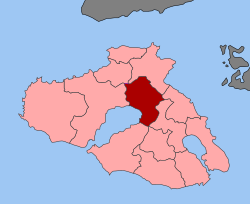Agia Paraskevi, Lesbos
|
Agia Paraskevi Αγία Παρασκευή |
|
|---|---|

The Village of Agia Paraskevi as seen from the Church of Agia Paraskevi
|
|
| Coordinates: 39°15′N 26°24′E / 39.250°N 26.400°ECoordinates: 39°15′N 26°24′E / 39.250°N 26.400°E | |
| Country | Greece |
| Administrative region | North Aegean |
| Regional unit | Lesbos |
| Municipality | Lesbos |
| • Municipal unit | 117.697 km2 (45.443 sq mi) |
| Elevation | 97 m (318 ft) |
| Population (2011) | |
| • Municipal unit | 2,497 |
| • Municipal unit density | 21/km2 (55/sq mi) |
| Community | |
| • Population | 2,234 (2011) |
| Time zone | EET (UTC+2) |
| • Summer (DST) | EEST (UTC+3) |
| Postal code | 811 xx |
| Area code(s) | 225x0-x |
| Vehicle registration | MH, MY |
| Website | www.agiaparaskevi.net |
Agia Paraskevi (Greek: Αγία Παρασκευή, also Ayia Paraskevi) is a village and a former municipality on the island of Lesbos, North Aegean, Greece. Since the 2011 local government reform it is part of the municipality Lesbos, of which it is a municipal unit. It is located in the central part of the island, on the northeast shore of the Bay of Kalloni.
The village (pop. 2,195 at the 2011 census) is named after the Church of Agia Paraskevi, which is found in a cave in one of the highest points of the town. The town cemetery is also located here. Presumably built over an old pagan temple, there is a well in the cave, and drinking the water from this well has been said to have conferred the Virgin Mary's protection. Agia Paraskevi is an old village that is becoming a powerful cultural and economic center for the island. The village is known for its old mansions, unique architecture and for its festivals.
The village contains many traditional houses that shows the Venetian and Roman occupation of the island and is a rare, non-commercialized, non-tourist village — locals sit at tavernas that line the main street and socialize. The people are quite friendly and get around on foot, moped, horse, mule, or donkey; however, the automobile has largely supplanted animals as the main mode of transportation of both people and farm produce.
Near the village at Klopedi, are the remains of the ancient Aeolian temple of Napaios Apollo, while Messa, also nearby, boasts the ruins of a big Ionian temple (late 4th–early 3rd century BC), possibly dedicated to three Greek deities: Zeus, Hera and Dionysos. A monument from a later date, the Early Christian basilica of St. George, restored by the noted mediaevalist, Professor A. Orlandos, may be seen at Halinados, not far away.
...
Wikipedia


